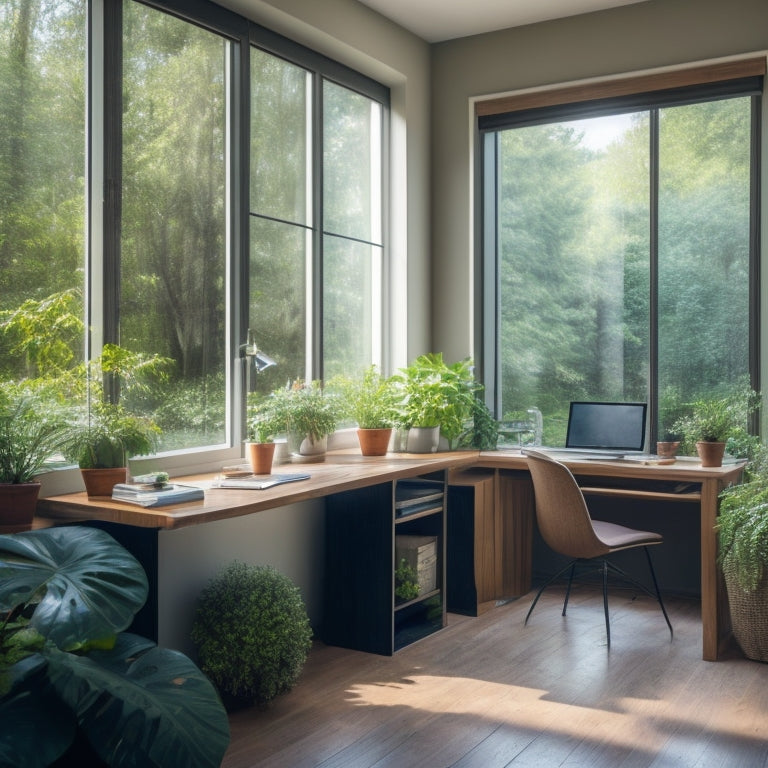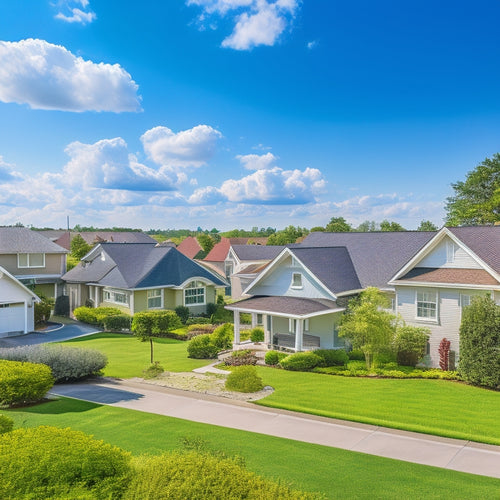
Why Upgrade Your Home Office Windows for Energy Efficiency?
Share
Upgrading your home office windows to energy-efficient ones can greatly reduce heat gain in summer and heat loss in winter, resulting in lower energy bills and a smaller carbon footprint. You'll also enjoy a more comfortable workspace with minimized temperature fluctuations and reduced noise pollution. In fact, energy-efficient windows can save you $126 to $465 annually on energy bills, and may even pay for themselves in 5 to 7 years. By making the switch, you'll not only enhance your productivity but also increase your home's overall value. Now, find out how to choose the right energy-efficient windows for your home office and start reaping the benefits.
Key Takeaways
- Upgrading home office windows to energy-efficient ones can save $126 to $465 annually on energy bills and pay for themselves in 5 to 7 years.
- Energy-efficient windows reduce heat gain in summer and heat loss in winter, improving indoor comfort and minimizing temperature fluctuations.
- They can increase overall home value significantly, with a potential ROI ranging from 70% to 80%, making them a valuable investment.
- Energy-efficient windows reduce noise pollution, creating a peaceful working environment, and can also improve focus and productivity.
- By choosing the right energy-efficient windows, homeowners can reduce their carbon footprint and contribute to a more sustainable future.
Benefits of Energy-Efficient Windows
Nearly 40% of the average home's energy losses occur through its windows, making energy-efficient windows a crucial consideration for homeowners. You can greatly reduce heat gain during summer and heat loss during winter by installing energy-efficient windows. This results in lower energy bills and a reduced carbon footprint, aligning with your sustainability practices.
By leveraging renewable energy, such as solar power, you can further minimize your carbon footprint and create a more sustainable future. Energy-efficient windows also improve indoor comfort by minimizing temperature fluctuations and reducing noise pollution.
You'll enjoy a more comfortable and peaceful working environment, allowing you to focus on your tasks without distractions. By upgrading to energy-efficient windows, you're not only saving energy but also creating a better workspace that supports your productivity and well-being.
Window Types for Energy Savings
You'll want to evaluate three key window types to maximize energy savings in your home office: double glazed options that reduce heat transfer, low-E glass benefits that minimize radiant heat gain, and vinyl frame choices that provide insulation and durability.
Incorporating sustainable practices, such as renewable energy sources for EV charging, can also enhance energy efficiency.
These window types can greatly impact your energy efficiency, and understanding their features is essential for making an informed decision.
Double Glazed Options
Energy efficiency in your home office starts with the right windows, and double glazed options are a popular choice for reducing heat loss and energy consumption. By installing double glazed windows, you can improve the thermal performance of your home office.
Double glazing involves two panes of glass separated by a gap, typically 10-20 mm, which acts as an insulator. This reduces heat transfer, minimizing energy loss in winter and heat gain in summer. As a result, you'll enjoy a more comfortable working space while reducing your energy bills.
Additionally, incorporating solar-powered charging stations can further reduce your carbon footprint and energy dependence. Regular maintenance, including cleaning and inspecting connections, is essential for optimizing performance and ensuring longevity.
Double glazed windows can help reduce noise pollution, creating a quieter and more focused work environment.
Low-E Glass Benefits
Optimizing your home office's thermal performance involves selecting the right window types, and low-E glass benefits take center stage in this pursuit. Low-E glass is a revolutionary element when it comes to energy efficiency, as it reduces heat transfer and minimizes solar gain. This means you'll enjoy a more comfortable working space while keeping your energy bills in check.
| Low-E Glass Benefits | Description |
|---|---|
| Reduces Heat Transfer | Low-E coatings minimize heat transfer, keeping your office warm in winter and cool in summer |
| Minimizes Solar Gain | Low-E glass reduces solar gain, preventing your office from overheating during summer months |
| Increases Energy Efficiency | By reducing heat transfer and solar gain, low-E glass helps you save energy and lower your bills |
| Enhances Comfort | With a more consistent indoor temperature, you'll enjoy a more comfortable working space |
Vinyl Frame Choices
When selecting window types for energy savings, vinyl frame choices emerge as a top consideration, given their ability to complement low-E glass benefits.
You'll find that vinyl frames offer exceptional durability, resisting warping, cracking, and fading to guarantee long-term performance. Moreover, vinyl color options are plentiful, allowing you to choose frames that seamlessly blend with your home office's aesthetic.
With vinyl frames, you can expect reduced maintenance, as they're resistant to rot, rust, and insect damage. Additionally, vinyl frames are often made from recycled materials, making them an eco-friendly choice.
In fact, incorporating renewable energy sources, such as solar-powered EV charging, can greatly reduce greenhouse gas emissions and air pollution, creating a more sustainable future.
Energy-Efficient Window Features
Your home office windows are only as good as their ability to regulate the flow of heat, light, and air. To achieve energy efficiency, look for windows with features that minimize heat transfer, reduce air leakage, and optimize natural light.
| Feature | Description |
|---|---|
| Double-pane glass | Two panes of glass separated by a gap, reducing heat transfer |
| Low-E coatings | Thin layers that reflect heat, reducing heat gain in summer and heat loss in winter |
| Insulation technology | Materials like foam or fiberglass that fill the gap between panes, reducing heat transfer |
| Sustainable materials | Frames made from recycled materials or sustainable sources, reducing environmental impact |
Home Office Window Replacement Cost
You're likely wondering how much it'll cost to replace your home office windows with energy-efficient ones.
The cost depends on the type of window replacement options you choose, such as full-frame replacement, insert replacement, or sash replacement.
By implementing time-of-use rate strategies, you can reduce your energy costs and invest the savings in energy-efficient windows.
On average, you can expect to pay between $300 and $1,000 per window, depending on factors like materials, size, and labor costs.
Window Replacement Options
Replacing the windows in your home office is an essential step towards achieving energy efficiency, and with various options available, it's important to evaluate the costs and benefits of each.
You'll need to contemplate different window styles, such as double-hung, casement, or sliding windows, each with its own unique features and benefits. For instance, double-hung windows provide excellent ventilation and are easy to clean, while casement windows offer unobstructed views and are highly energy-efficient.
Additionally, reflect on installation tips, such as ensuring proper sealing and insulation to maximize energy savings.
Average Cost Breakdown
When evaluating window replacement options for your home office, it's crucial to reflect on the costs involved in this investment. You'll want to evaluate the upfront installation costs and weigh them against the long-term savings you'll gain from energy-efficient windows.
| Cost Category | Average Cost |
|---|---|
| Window Unit | $300 - $1,000 |
| Installation Labor | $200 - $500 |
| Permits and Inspections | $100 - $300 |
| Total Average Cost | $600 - $1,800 |
Keep in mind that these costs vary depending on factors like window size, material, and local labor rates. While the initial investment may seem steep, energy-efficient windows can save you up to $465 per year on energy bills, making them a worthwhile investment for your home office.
How to Choose the Right Windows
Choosing the right windows for your home office is vital to achieving maximum energy efficiency.
You'll want to take into account various window styles, such as double-hung, casement, or awning windows, each with its own benefits and drawbacks. When selecting windows, look for low-E coatings, double- or triple-paned glass, and insulated frames to minimize heat transfer.
Additionally, assess the window's U-factor, which measures its ability to prevent heat loss. Proper installation is also important, so verify your installer follows best practices, such as flashing and sealing the windows correctly.
Window Treatments for Energy Efficiency
Now that you've selected and installed energy-efficient windows, it's time to reflect on the role window treatments play in maintaining a comfortable and energy-efficient home office.
Window treatments can greatly influence the energy efficiency of your home office by controlling the amount of sunlight that enters the room. Here are some window treatment options to evaluate:
-
Solar shades: block UV rays and reduce heat gain during summer
-
Blackout curtains: keep the room dark and cool during peak sun hours
-
Thermal blinds: provide insulation and reduce heat loss during winter
- Roller shades with window films: allow natural light while reducing glare and heat gain
Additionally, think about sheer panels, insulated drapes, and decorative valances to enhance the aesthetic appeal of your home office while maintaining energy efficiency.
Energy Efficiency Window Upgrades ROI
Frequently, homeowners wonder whether investing in energy-efficient window upgrades is a worthwhile expense. When considering an upgrade, you're likely thinking about the return on investment (ROI).
Energy-efficient windows can provide significant energy savings, which translate to cost savings over time. According to the U.S. Department of Energy, energy-efficient windows can save you $126 to $465 per year on your energy bills. This means your new windows can pay for themselves in as little as five to seven years.
Additionally, energy-efficient windows can increase your home's value, making them a beneficial investment. With a potential ROI of 70% to 80%, upgrading to energy-efficient windows is a smart decision for your wallet and the environment.
Frequently Asked Questions
Can I Install Energy-Efficient Windows Myself or Do I Need a Professional?
You can attempt a DIY installation, but it's essential to take into account your skills and the type of windows you're dealing with; for instance, complex window types like triple-pane or custom designs may require a professional's knowledge.
Will New Windows Affect the Aesthetic of My Home Office's Exterior?
You might worry that new windows will alter your home office's exterior look, but you'll find that modern, energy-efficient options blend seamlessly with your existing aesthetic, preserving curb appeal with various window styles to choose from that fit your unique taste.
Do Energy-Efficient Windows Require More Maintenance Than Regular Windows?
You'll find that energy-efficient windows require minimal maintenance, similar to regular ones, and their advanced coatings and frames guarantee cost savings and reduced environmental impact, giving you more freedom to focus on your work without worrying about upkeep.
Are Energy-Efficient Windows Compatible With My Existing Window Frames?
Did you know 70% of old windows can be retrofitted with energy-efficient units? You'll be happy to know that, yes, energy-efficient windows are compatible with your existing window frames, but installation requirements may vary depending on the frame material and condition.
Can I Replace Only Some of My Windows or Do I Need to Replace All?
You're wondering if you need to replace all windows at once. The answer is no, but consider cost considerations and window types. Replacing only some windows may not be cost-effective, as you'll still have inefficient windows affecting your energy bills.
Related Posts
-

What Cool Roof Tax Breaks Can Homeowners Claim?
You can claim federal tax credits of up to $500 and state and local incentives for installing cool roofs, which not o...
-

7 Best Home Hydrogen Fuel Cells for Clean Power
You're considering adopting hydrogen fuel cells for clean power at home, but you want to know the best options. Reput...
-

7 Top HEPA Filters for Green Building Projects
You need a reliable HEPA filter for your green building project that aligns with your sustainable goals and guarantee...


